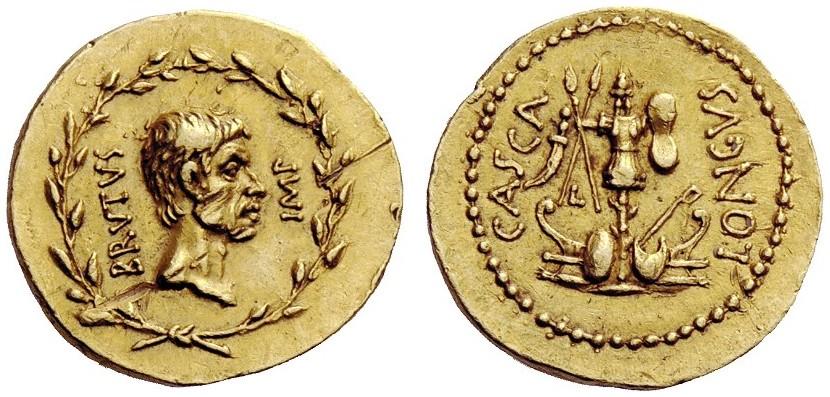Abydus (Roman Republic), gold, aurei (Brutus/trophy) (RRC 507/1 Casca Longus 43-42 BCE)
From SILVER
(Redirected from Abydus, gold, aurei (RRC 507/1 Casca Longus 43-42 BCE))
43 BCE - 42 BCE Gold 3,317 kg
Description
| ObverseInscription or printing placed on the obverse.: | BRVTVS – IMP (Latin).Bare head of Brutus r. within laurel wreath |
| ReverseInscription or printing placed on the reverse.: | CASCA – LONGVS (Latin).Trophy, with curved sword and two spears on l. and figure-of-eight shield on r., mounted on a post set on a base formed by two prows back to back. Two shields are placed on the front of the prows and a sword with square handle extends to r. In inner l. field, L. |
Mint and issuing power
| MintIdentifies the place of manufacture or issue of a numismatic object.: | Abydus | Ancient regionAncient region.: | Troas | Modern countryModern country: Turkey | AuthorityIdentifies the issuing power. The authority can be "pretended" when the name or the portrait of X is on the coin but he/she was not the issuing power. It can also be "uncertain" when there is no mention of X on the coin but he/she was the issuing power according to the historical sources: | Roman Republic |
Chronology
| FromIdentifies the initial date in a range assigned in a numismatic context. | 43 BCE | toIdentifies the final date in a range assigned in a numismatic context.. | 42 BCE | PeriodTime period of the numismatic object.: Roman from 30 BC |
Physical description
| MetalThe physical material (usually metal) from which an object is made.: | Gold |
Median weightMedian of the weights of numismatic objects (in grams). in grams | 8.05 | DenominationTerm indicating the value of a numismatic object. Examples: tetradrachm, chalkous, denarius.: | aureus | StandardStandard.: |
Image

Casca_Longus_aurei.jpg [1]
References
| Die study referencePublication of the study: | Hollstein 20161Hollstein 2016 | ||
| Coin series referenceReference to coin series study: | RRC2RRC, n° 507/1 | ||
| Coin series web referenceCoin series web references: | |||
Obverse dies distribution
| FrequencyFrequency of specimen in distribution. ᵖ | Number of obversesNumber of obverse dies. ᵖ (o) | % (o) | Number of coinsNumber of coins. (n) | % (n) | Die nameName(s) of the die(s). |
| 3 | 1 | 50 | 3 | 17.65 | A |
| 14 | 1 | 50 | 14 | 82.35 | B |
| Total | 2 of 2 | 100 | 17 of 17 | 100 |
Reverse dies distribution
no distribution is available
Quantification
| Number of obversesNumber of obverse dies. ᵖ (o) | 2 | Number of singletons (o1)The number of singleton coins. ᵖ | 0 |
| Number of reverse diesNumber of reverse dies. (r) | 4 | Number of coinsNumber of coins. (n) | 17 |
| Coins per obverse dieNumber of coins per obverse die. (n/o) | 8.5 | Coins per reverse dieNumber of coins per reverse die. (n/r) | 4.25 |
| Reverse per obverse ratioRatio of obverse dies divided by reverse dies. (r/o) | 2 | Percentage of singletons (o1)number of coins (n) divided by the number of singletons (o1) ᵖ | 0 % |
| Original number of dies (O) (Carter 1983 formula)The estimation of the number of coins according to Carter 1983 ᵖ | 2.06 | Coins struck if 20,000 as average productivity per dieCoins made if the average productivity for obverses (according to Carter) is 20,000. ᵖ | 41,200 |
| Original number of dies (O) (Esty 2011 formula)The estimation of the number of coins according to the singleton formula in Esty 2011 ᵖ (O) | 2.27 | Survival rate if 20,000 as average productivity per dieSurvival rate if average productivity is 20,000. ᵖ | 0.00041 |
| Coverage (o = % of O) (Esty 1984 formula)Esty 1984 - coverage (% of O) ᵖ (o = % of O) | 100% | Die productivity if survival rate 1/2,000Average productivity if survival rate is 1/2,000. ᵖ | 16,504.85 |
| Weight of silver (in kg) if 20,000 coins per die (O = Carter formula)Carter 1983 * Median weight * 20000 (*10 if gold or electrum) ᵖ | 3,317 kg <br /> 3,317 kg | Die productivity if survival rate 1/5,000Average productivity if survival rate is 1/5,000. ᵖ | 41,262.14 |
Remarks
Most likely one single workstation Certainly military